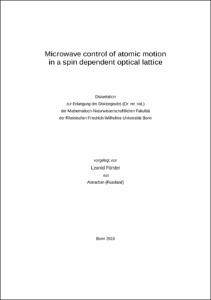Microwave control of atomic motion in a spin dependent optical lattice

Microwave control of atomic motion in a spin dependent optical lattice

| dc.contributor.advisor | Meschede, Dieter | |
| dc.contributor.author | Förster, Leonid | |
| dc.date.accessioned | 2020-04-15T19:18:08Z | |
| dc.date.available | 2020-04-15T19:18:08Z | |
| dc.date.issued | 15.10.2010 | |
| dc.identifier.uri | https://hdl.handle.net/20.500.11811/4660 | |
| dc.description.abstract | The subject of this work is the control of the quantum mechanical motional state of trapped neutral Cesium atoms. This is accomplished using a rarely considered method based on microwave radiation in combination with a spin dependent optical lattice potential. The setup used was designed to trap and to store on the order of ten atoms in a one dimensional optical lattice. Fluorescence imaging allows to determine both, the number and the position of the atoms. The spin degree of freedom is manipulated using microwave radiation and the trapping potential allows to shift the atoms to the 'left' or to the 'right' along the potential axis, depending on their spin orientation. A microwave spectrum with a slightly displaced lattice exhibits sideband peaks corresponding to a change of the vibrational quantum number. This is the mechanism which introduces coupling between the spin and the motional degree of freedom. The work draws parallels to the usually used sideband technique based on optical transitions instead of microwaves and exploiting the photon recoil instead of a state dependent potential. Similar to the optical method the microwave based approach allows for the realization of a resolved-sideband cooling technique which efficiently prepares the atomic ensemble in the motional ground state. Starting from this purified quantum mechanical state, other interesting states are prepared using successive sideband transitions. The result of the preparation is probed by implementing filtering schemes for the motional state. With this control technique the experimental setup in total is capable to control the spin, the position along the one dimensional periodic potential and the vibrational state of the atoms. | |
| dc.description.abstract | Mikrowellenbasierte Kontrolle über den atomaren Bewegungszustand in einem optischen Gitter Das Thema dieser Arbeit ist die Manipulation der quantenmechanischen Ortswellenfunktion von neutralen Cäsiumatomen, die sich wohl lokalisiert in dem Potential einer Dipolfalle befinden. Dazu wird eine wenig untersuchte Methode verwendet, die auf Mikrowellenübergängen in Kombination mit einem spinabhängigen Potential basiert. Der verwendete Aufbau ist dafür konzipiert worden, etwa zehn Atome in einem eindimensionalen optischen Gitter zu speichern. Die Anzahl der Atome und deren Position entlang der Potentialachse werden durch Fluoreszenzabbildung bestimmt. Während der atomare Spin mittels Mikrowellenpulsen manipuliert werden kann, erlaubt die Dipolfalle den Transport von Atomen nach 'links' oder nach 'rechts', abhängig von deren Spinausrichtung. Ein Mikrowellenspektrum in einer Konfiguration mit leicht versetzten spinabhängigen Potentialen weist Seitenbänder auf, die von einem Wechsel der vibronischen Quantenzahl herrühren. Dieser Mechanismus stellt die Grundlage für die Kopplung zwischen dem Spin- und dem Vibrationsfreiheitsgrad dar. In der Arbeit werden die Parallelen aufgezeigt zu der üblicherweise verwendeten Seitenbandmethode, die auf optischen Übergängen statt auf Mikrowellen basiert und den Photonenrückstoß ausnutzt anstatt ein spinabhängiges Potential. Ähnlich zu der optischen Methode erlaubt der mikrowellenbasierte Ansatz die Implementierung eines Seitenbandkühlschemas, was das atomare Ensemble effizient im vibronischen Grundzustand präpariert. Ausgehend von dem reinen quantenmechanischen Ausgangszustand lassen sich durch sukzessive Anwendung von Seitenbandübergängen weitere interessante Bewegungszustände präparieren. Das Resultat wird durch ein Filterschema für die Vibrationsquantenzahl verifiziert. Insgesamt bietet der experimenteller Aufbau damit die Kontrolle über den Spinfreiheitsgrad, über die Position der Atome entlang des periodischen Potentials und über die atomare Ortswellenfunktion. | |
| dc.language.iso | eng | |
| dc.rights | In Copyright | |
| dc.rights.uri | http://rightsstatements.org/vocab/InC/1.0/ | |
| dc.subject | Kalte Atome | |
| dc.subject | Optisches Gitter | |
| dc.subject | Seitenband Kühlung | |
| dc.subject | Quanteninformation | |
| dc.subject | Zustandsabhängiges Potential | |
| dc.subject | cold atoms | |
| dc.subject | optical lattice | |
| dc.subject | sideband cooling | |
| dc.subject | quantum information | |
| dc.subject | state dependent potential | |
| dc.subject.ddc | 530 Physik | |
| dc.title | Microwave control of atomic motion in a spin dependent optical lattice | |
| dc.type | Dissertation oder Habilitation | |
| dc.publisher.name | Universitäts- und Landesbibliothek Bonn | |
| dc.publisher.location | Bonn | |
| dc.rights.accessRights | openAccess | |
| dc.identifier.urn | https://nbn-resolving.org/urn:nbn:de:hbz:5N-22879 | |
| ulbbn.pubtype | Erstveröffentlichung | |
| ulbbnediss.affiliation.name | Rheinische Friedrich-Wilhelms-Universität Bonn | |
| ulbbnediss.affiliation.location | Bonn | |
| ulbbnediss.thesis.level | Dissertation | |
| ulbbnediss.dissID | 2287 | |
| ulbbnediss.date.accepted | 10.05.2010 | |
| ulbbnediss.fakultaet | Mathematisch-Naturwissenschaftliche Fakultät | |
| dc.contributor.coReferee | Weitz, Martin |
Files in this item
This item appears in the following Collection(s)
-
E-Dissertationen (4116)




